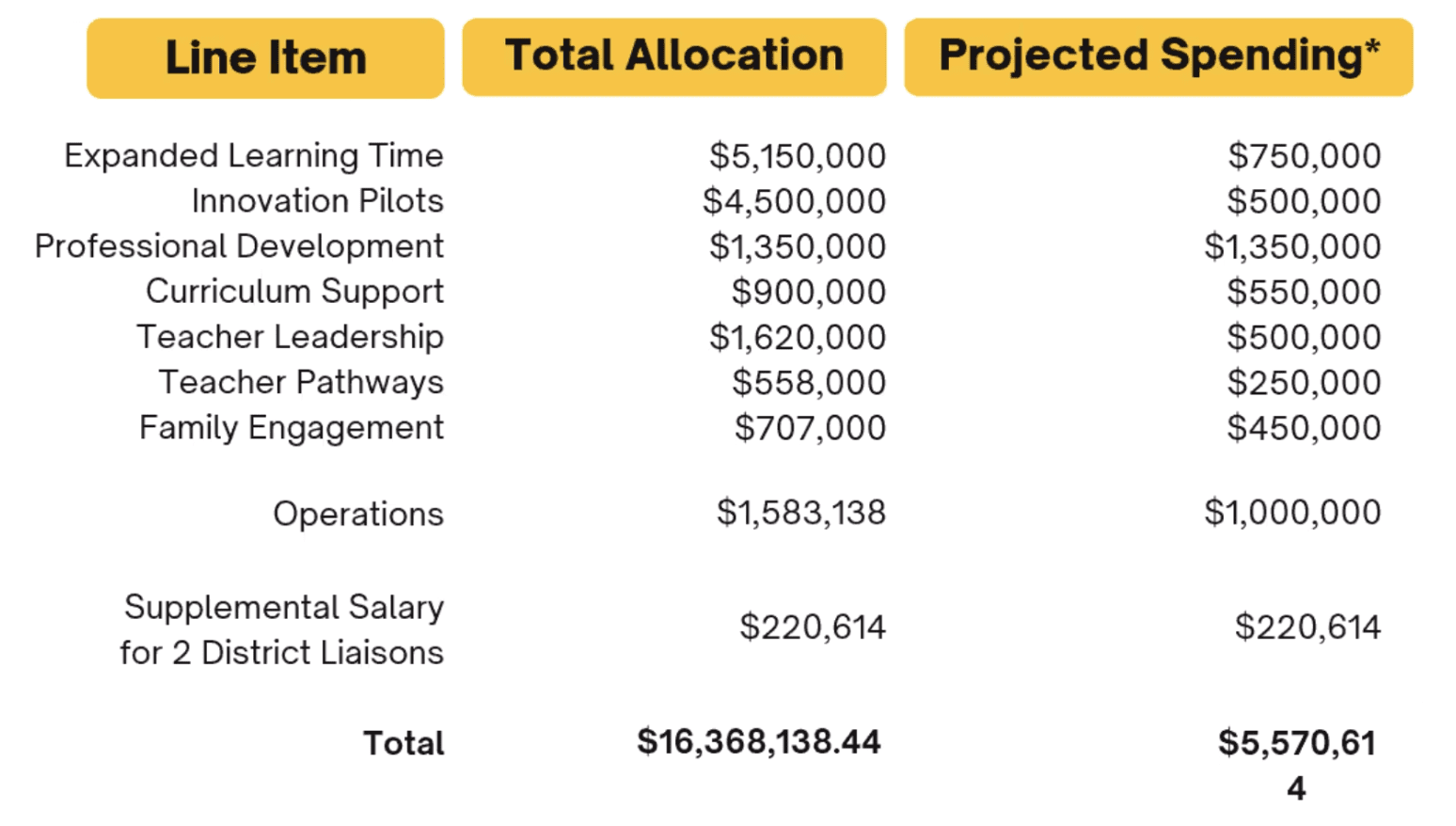
The Department of Education, Redding Consortium and Wilmington Learning Collaborative had their yearly state budget requests Wednesday.
Education – what one legislator called the most important investment by the state – consumed Wednesday’s Joint Finance Committee hearing for a category that makes up about one-third of the state’s $6 billion budget.
Appearing in the morning before the committee that decided how and where the state’s budget will be spent was The Redding Consortium and the Wilmington Learning Collaborative.
Together, they asked for tens of millions of dollars to spend to improve education in Wilmington and New Castle County, specifically for at-risk and underserved students.
After them, the state’s Department of Education requested more than $2 billion.
Department of Education
The Department of Education has $2.1 billion penciled in under Gov. John Carney’s recommended budget for Fiscal Year 2025, a 7.9% increase from this year.
Education Secretary Mark Holodick started his presentation by stating that the state’s struggles with literacy are unacceptable.
He and legislators have consistently said that it is crucial students learn to read by grade three.
After that, it becomes much harder, and learning in school depends on students being able to read.
The department’s priorities for next year are literacy, early childhood education, recruitment and retention of educators, mental health and wellbeing, and school safety and security.
Holodick noted many schools have school resource officers and constables, as well as created secure vestibules at the entrance of buildings.
RELATED: Constables: What are they; why so many are being hired
Legislators asked if there’s a curriculum requirement in early childhood education center.
Some had heard of centers that plop children in front of television screens and call it a day, comparing it to babysitting.
Holodick said the department has curriculum recommendations, and using televisions as babysitters was certainly happening, but that in recent years that’s been eclipsed by more advanced ways to teach the state’s youngest learners.
In addressing literacy, he said more districts are hiring reading specialists, but they often bounce from school to school every couple pf years. which creates challenges.
Several legislators said, and Holodick agreed, that the abundance of education legislation in recent years has put a burden on teachers and schools.
Notably, teachers have required professional development to understand how to teach using the mandated science of reading, which relies on the science of how children learn.
It has six essential components: phonemic awareness, phonics, reading fluency, vocabulary, text comprehension and oral language.
Other legislation has required schools to hire more mental health specialists, schools to incorporate a Black history curriculum, developmental screenings for young learners and more.
It can be a lot to deal with, Holodick said.
Redding Consortium
The Redding Consortium for Educational Equity is seeking $10.2 million in fiscal year 2025, which is included in Carney’s recommended budget.
The consortium, created in 2019, recommends policies and practices to the state to achieve educational equity and improve educational outcomes for all pre-K through twelth grade students in the city of Wilmington and northern New Castle County.
The lionshare of the funding would go to wraparound services and state-funded full-day pre-K.
RELATED: Kuumba’s $2.4M grant will expand wellness, after school programs
Wraparound services include before and after-school programs, summer programs and in-school wellness centers, which typically involve a partnership with local health care agencies to provide immediate mental or physical care for students.
The consortium has about $2 million in carry-over funds from last year, which it plans to use on created an equity data dashboard the public can use to see racial-equity data involving city students and educators.
RELATED: New Castle launches 4 elementary wellness centers
It also will be used for the Boost 22-26 initiative, a cross-district effort focused on improving graduation rates for high school students in Wilmington through tailored academic support from graduation coaches.
RELATED: Boost ’22 Collab Results In 88% Of City Students Graduating
Matt Denn and Sen. Elizabeth “Tizzy” Lockman, D-Wilmington – the two co-chairs of the consortium – also touted the group’s whole school professional development program. It’s a teacher-leader program for educators in schools with large concentrations of students in poverty.
Rep. Kim Williams, D-Marshallton, a JFC member and head of the House Education Committee, requested data on whether those teachers stay in the schools since teacher retention has been a national problem.
“I think it’s important to see because for us as a body, and spending money, we need to make sure that these programs are working where we have these educators that are staying in these schools,” she said.
Williams also said it’s important to track students’ progress from early years onward, since many of them do not start at the same level.
Sen. Laura Sturgeon, a JFC member and chair of the Senate Education Committee, asked how the consortium would define success.
“There’s a lot of definitions out there that people throw around, like test scores… but there are other forms of success and given the amount of state dollars going into this I’m curious what you would consider success,” she said. “I’m very open to outside the box thinking because I’m not overly committed to the idea that the only true measure of success is a number on a test score.”
Lockman said test scores are a data point the consortium tracks and values, as well as how the consortium’s ongoing projects are going. She also said climate indicators help measure success.
“The retention of educators, but also the attendance of students is obviously a big one,” she said. “Just indicators that people want to be there, that they are thriving in that space in ways other than just how they’re performing on a test.”
Sturgeon said if a student can go on to become a contributing member of society, whether their test scores are exemplary or not, it’s a true sign of success.
Denn added that schools receiving wraparound service grants are required to track objective outcomes, and also family involvement.
Sturgeon suggested that one day, the whole state could use the services of the consortium.
Sen. Eric Buckson, R-Dover, a member of the JFC and the Senate Education Committee, recommended that there be a conversation about the facilities the children are in and a better mechanism for improving those facilities.
He pointed out that many districts must have taxpayer referendums to raise funds to improve buildings.
Sen. Dave Lawson, R-Marydel, expressed frustration that there’s so much money going to services that only benefit a handful of schools in the state.
Wilmington Learning Collaborative
The Wilmington Learning Collaborative is made up of nine city of Wilmington schools across the Brandywine, Christina and Red Clay school districts.
It serves about 3,000 students, and hopes to give families and educators a voice in policy-making to help improve both academic and societal outcomes for those students.
Wrapping up its second planning year, its executive director Laura Burgos presented a budget of more than $16 million to the Joint Finance Committee.
Burgos said the initial school reports from all nine schools should be received by the end of February.
It will contain data on the current state of the school, as well as needs and potential programs to improve and more.
RELATED: WLC hires 2, completes school assessments
The collaborative has similar goals to the Redding Consortium, and the two have been working together to align their programming, which the committee members repeatedly said is crucial.
One of their common initiatives is professional development, and Burgos said it’s vital that teachers stay in schools with vulnerable students.
“Honestly, vacancies in WLC schools shouldn’t exist because every district should be prioritizing those vacancies over all others,” she said. “We have a unique opportunity as the Wilmington Learning Collaborative to explore national models, partnerships with local universities, partnerships with entities such as tech and pharma.”
She also said the collaborative needs to continue to solidify its identity and brand within the community as it wraps up its planning period and begins to implement more programs.
It’s soon to launch a one-stop website for the public to have access to all information surrounding the group.
It has thrown around the idea of establishing community advisory boards. In May, the collaborative plans on making a summer professional learning plan and school performance framework in June.
During this time, it also plans on establishing measurable outcomes, like academic growth and proficiency, on-track attendance, teacher retention, health and wellness, and school climate.
Sturgeon asked if a goal of the collaborative is to have a curriculum sequence, so that if a student moves from one school to another, they won’t miss something or fall back behind.
Absolutely, Burgos said.
Rep. Charles Postles, R-Milford, asked about the success of cross-district collaboration. The three districts in the collaborative are three of the largest, and he pointed out how that partnership could present some challenges.
Burgos said that establishing expectations and holding the nine schools accountable helps.
Also, there’s district liaisons for all three who help communicate between the districts and the collaborative’s governing council.

Raised in Doylestown, Pennsylvania, Jarek earned a B.A. in journalism and a B.A. in political science from Temple University in 2021. After running CNN’s Michael Smerconish’s YouTube channel, Jarek became a reporter for the Bucks County Herald before joining Delaware LIVE News.
Jarek can be reached by email at [email protected] or by phone at (215) 450-9982. Follow him on Twitter @jarekrutz
Share this Post





